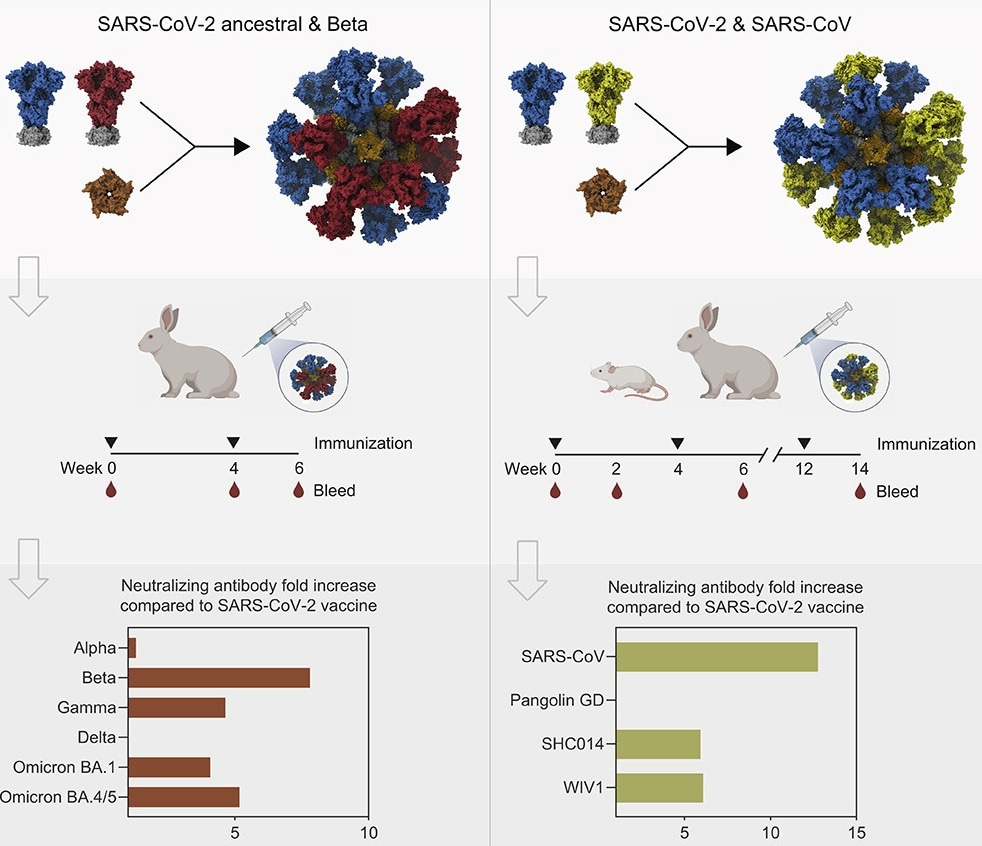Coronavirus disease 2019 (COVID-19) vaccines are based on the spike protein of the severe acute respiratory syndrome coronavirus 2 (SARS-CoV-2) Wuhan-Hu-1 strain. Mutant SARS-CoV-2 variants are less sensitive to immune responses elicited by these vaccines. As such, vaccines incorporating sequence diversity may augment protection against novel SARS-CoV-2 variants.
Previously, the authors described a two-component NP vaccine (I53-50) that induced neutralizing antibodies (nAbs) against SARS-CoV-2 in animal models. The I53-50 NP contains a 20-trimer component (I53-50A, component A) and a 12-pentamer component (I53-50B, component B). The two components assemble into icosahedral particles.

Study: Co-display of diverse Spike proteins on nanoparticles broadens sarbecovirus neutralizing antibody responses.
The study and findings
In the present study, researchers leveraged the I53-50 platform to co-display diverse spike proteins and evaluated the immune responses. First, they fused the N-terminus of component A to the C-terminus of the Beta variant’s spike protein through a glycine-serine linker. Then, after purification, the spike-A fusion protein was mixed with an equimolar quantity of component B for assembly.
Mosaic NPs (co-displaying different spike proteins) were generated by mixing appropriate spike-A fusion proteins (of ancestral strain and Beta variant) at equimolar quantities before adding component B. Negative stain electron microscopy confirmed the assembly of the NPs. Biolayer interferometry (BLI)-based assay revealed strong binding to the ancestral spike NPs by specific monoclonal antibodies (mAbs).
Likewise, Beta-specific mAbs showed robust binding to NPs displaying the Beta spike protein. Some ancestral spike-specific mAbs (that do not bind to the Beta spike) and another mAb with a reduced potency for the Beta spike exhibited intermediate binding to the mosaic NPs. Next, the authors immunized rabbits at weeks 0 and 4 with ancestral spike NPs, Beta spike NPs, a cocktail of ancestral and Beta spike NPs, or mosaic NPs, and bled them at 0, 4, and 6 weeks.
A pseudovirus neutralization assay was performed to assess the neutralization of SARS-CoV-2 variants of concern (VOCs), SARS-CoV-1, and animal CoVs (pangolin GD, WIV1, and SHC014). Ancestral spike NPs induced the most potent nAbs against ancestral strain but weaker against variants, with substantially lower titers against Beta and Omicron variants.
The neutralizing titers of Beta spike, cocktail, and mosaic NPs against ancestral strain, Alpha, and Delta variants were similar but improved several-fold against Beta, Gamma, and Omicron variants relative to ancestral spike NPs. All immunized animals elicited significant neutralizing responses against SARS-CoV-1 and animal CoVs.
Next, the researchers generated NPs displaying the SARS-CoV-1 spike and mosaic NPs co-displaying spikes from SARS-CoV-1 and SARS-CoV-2. Like earlier, the BLI-based assay confirmed the generation of mosaic NPs. Next, the researchers evaluated the immunogenicity of cocktail and mosaic NPs of SARS-CoV-1 and SARS-CoV-2 spikes in rabbits and mice.
BALB/c mice and rabbits were immunized with the cocktail or mosaic NPs at 0, 4, and 12 weeks and bled at zero- and two weeks post-immunization. The authors re-analyzed data from previous studies that used the SARS-CoV-2 soluble spike antigen and NPs to immunize rabbits and mice using the same dosing regimen. SARS-CoV-2 spike NPs elicited three-fold greater neutralization than other immunogens in mice, albeit this was not statistically significant.
Immunization with soluble SARS-CoV-2 spike induced the most potent neutralizing responses against ancestral SARS-CoV-2 in rabbits. The nAb responses induced by mosaic NPs and the cocktail were lower than those elicited by the soluble spike antigen. However, nAb titers were significantly more potent with the cocktail and mosaic NPs against SARS-CoV-1 than SARS-CoV-2 soluble spike antigens or NPs.
All immunogens induced nAbs against the animal CoV SHC014. Cocktail and mosaic NPs induced the most robust nAb responses against SHC014. Cocktail and mosaic NPs showed neutralization against pangolin GD CoV to similar levels as SARS-CoV-2 spike NPs. Finally, serum samples from immunized rabbits were tested for neutralization against SARS-CoV-2 VOCs.
The cocktail and mosaic NPs elicited approximately two to three-fold lower nAb titers against the ancestral strain and VOCs than those induced by the SARS-CoV-2 soluble spike antigen and NPs. The neutralizing potency against SARS-CoV-2 VOCs increased after the third immunization (at week 12), with 2 to 18-fold higher titers in those immunized with soluble antigens or spike NPs.
Conclusions
The authors noted that immunization with the ancestral spike protein induced the weakest nAb responses against SARS-CoV-2 Omicron. Intriguingly, nAb responses against the Omicron variant improved the most upon the third immunization. To summarize, the results demonstrated that spike proteins from different SARS-CoV-2 variants and SARS-CoV-1 can be co-displayed on the I53-50 NP platform for broad neutralizing responses. Further, mosaic NPs that induce pan-sarbecovirus immunity could be protective against future variants.